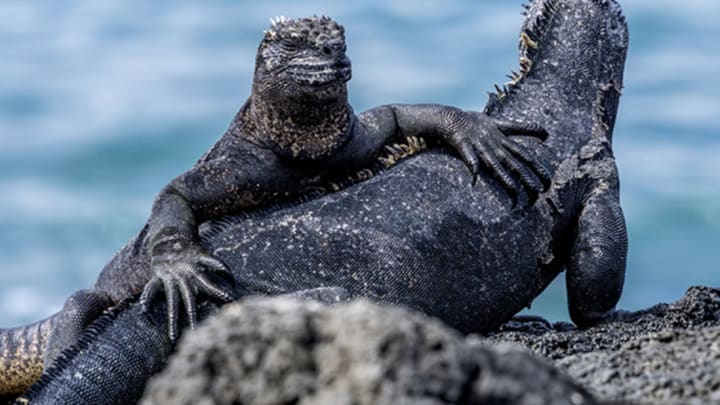I generally think of Charles Darwin as a nice man—a barnacle collectin’, Shakespeare-quoting abolitionist who loved dogs. And, since he plays a prominent role in evolutionary theory, I just assumed he loved all animals. Equally.
It turns out, he did not.
In all of the Charles Darwin writing I’ve read (very limited), I have NEVER seen him throw shade at a creature the way he tosses it at the Marine Iguana. This is what two marine iguanas, possibly talking about how much they hate Charles Darwin, look like:

iStock
Does the marine iguana really deserve to be called an “Imp of Darkness,” as the Father of Evolution liked to call them? Maybe, but Darwin doesn’t stop there. Here’s how he described the creatures in his 1839’s Voyage of the Beagle:
“[The marine iguana] is a hideous-looking creature, of a dirty black colour, stupid and sluggish in its movements.”
Admittedly, the “wig” the marine iguana wears—made from sneezing excess sea salt onto its head—doesn’t give it the dignified look of, say, a London barrister. And you can see from the creature’s awkward gait why it’s never picked first in gym class.
When Darwin does praise the creatures, he seems to undercut it immediately. In a compliment about the lizard’s agile and effortless swimming (they tuck their arms in and glide along by wiggling their bodies), he reminds you that the repulsive creatures look “serpentine” while they do it. When he talks up their claws as “admirably adapted for crawling over the rugged” lava, he then goes on to call them do-nothings: “these hideous reptiles may oftentimes be seen on the black rocks, a few feet above the surf, basking in the sun with outstretched legs.” Not sure he needed the word “hideous” again in there.
But Darwin doesn’t just throw shade at iguanas; he also takes pleasure in throwing the iguanas themselves. Here’s an excerpt from Darwin after he realized the 20-lb herbivores didn’t bite:
“One day I carried one to a deep pool left by the retiring tide, and threw it in several times as far as I was able. It invariably returned in a direct line to the spot where I stood…. As soon as it thought the danger was past, it crawled out on the dry rocks and shuffled away as quickly as it could. I several times caught this same lizard… and though possessed of such perfect powers of diving and swimming, nothing would induce it to enter the water, and so often as I threw it in, it returned...”
But Charlie Darwin wasn’t content with insulting the animals on the page and hurling the animals into the sea. Before he left the island, he also insulted their relatives, the land iguanas: “These lizards, like their brothers the sea-kind, are ugly animals; and from their low facial angle have a singularly stupid appearance.”
And Darwin also harassed this creature in the name of science. “I watched one for a long time, till half its body was buried; I then walked up and pulled it by the tail; at this it was greatly astonished, and soon shuffled up to see what was the matter; and then stared me in the face, as much as to say, “What made you pull my tail?”
Indeed, the recordings above made me wonder why Charles Darwin, lover of animals, was such an iguana bully. Well, the truth is, he didn’t always hate the creatures. A few pages later, he does offer a few kind words:
“The meat of these animals when cooked is white, and by those whose stomachs rise above all prejudices, it is relished as very good food.”
Good food, indeed! Of course, however ugly and dumb he thought marine and land iguanas were, investigating and understanding the creatures did help him in establishing his theories of evolution.
